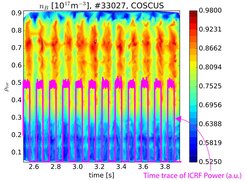Experimental determination of boron transport properties in ASDEX Upgrade plasmas
The transport properties of boron ions in ASDEX Upgrade plasmas have been determined experimentally and compared to theoretical predictions. This information is important to the success of the fusion program, as future magnetic confinement fusion reactors will have to control the transport of both low- and high-Z elements in the plasma in order to produce net fusion power.

At ASDEX Upgrade a new method for measuring the transport coefficients of boron ions in the plasma has been discovered, developed, and exploited. When ion cyclotron resonant frequency (ICRF) waves are launched into the plasma a concomitant increase in the boron density that propagates from the plasma edge to the core is also observed. This creates a time dependent modulation of the boron density from which the transport coefficients can be determined. The data shows that using neutral beam heating results in outward convection of low-Z impurities, likely connected to the strong ion temperature gradients, rotation gradients, and high Mach numbers observed under these conditions. Conversely, the use of strong electron heating, resulting in comparatively lower ion temperature gradients and plasma rotation, leads to inward convection and an increase in the diffusion coefficient. Detailed comparison to theoretical predictions showed that while the measured diffusion coefficients are well described by turbulent transport theory, the high outward convection observed at high ion temperature and rotation gradient are not captured by the simulations.
For this work Cecilia Bruhn received her doctorate from TUM on 01/08/2019.
Details can be found in Plasma Physics and Controlled Fusion, 60 (2018) 085011.
Open Access article.
